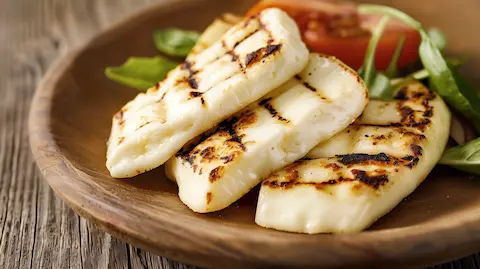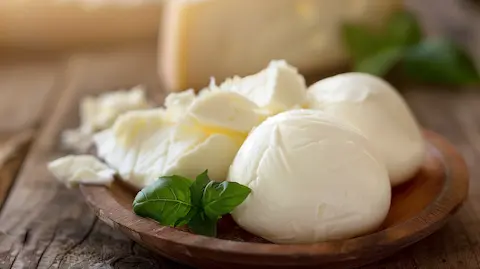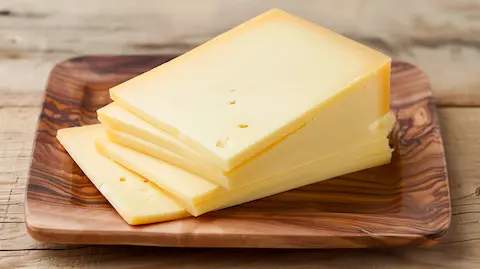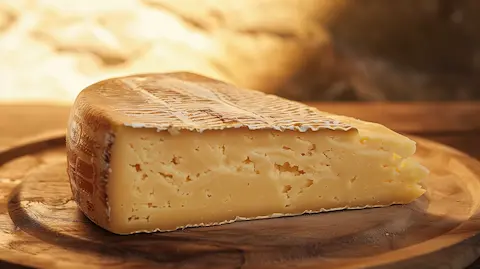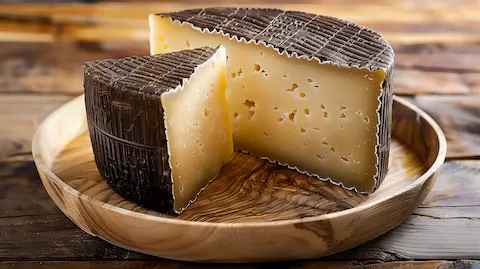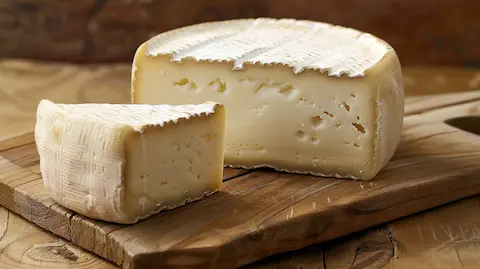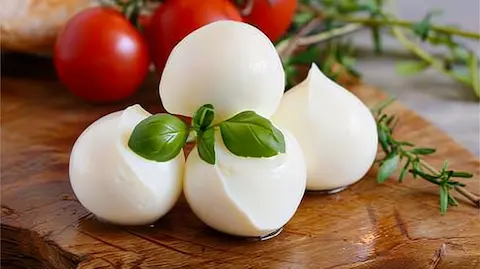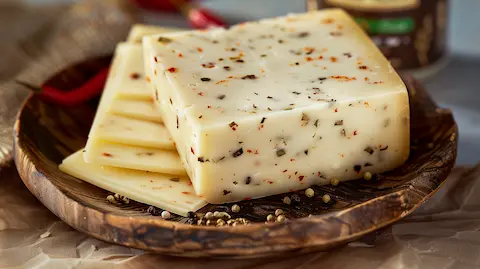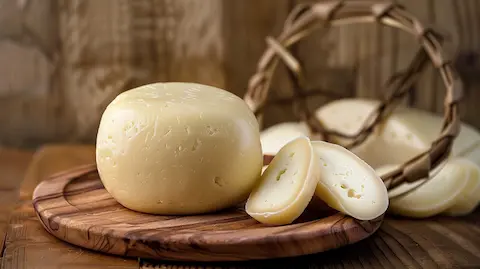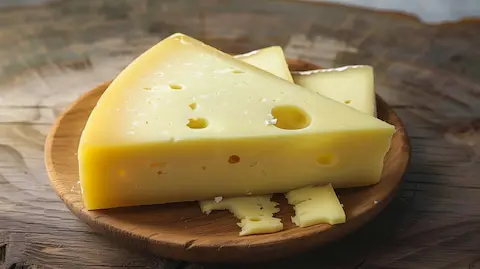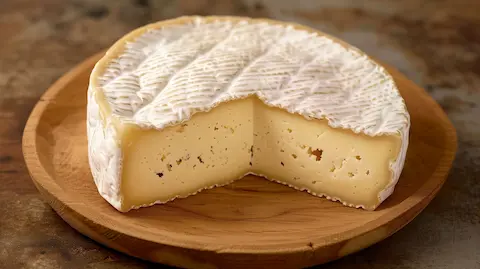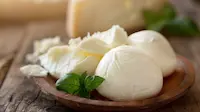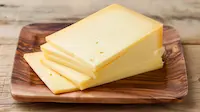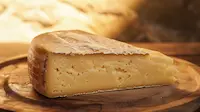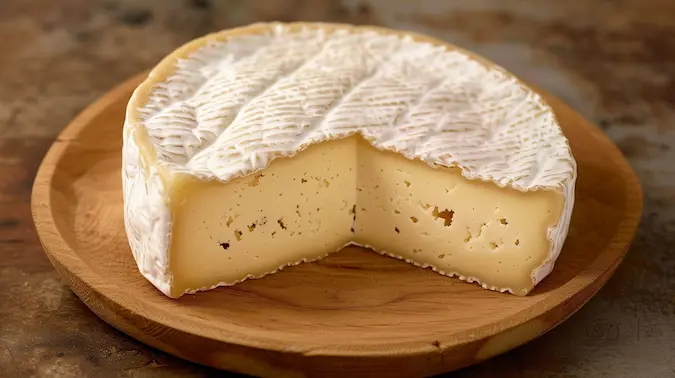Neufchatel Cheese
Neufchatel, a luscious French cheese with roots stretching back to the 6th century, is a testament to the art of cheese-making. Originating from the town of Neufchatel in Normandy, this cheese may very well be the oldest known in France. With a process that has stayed true to its heritage, Neufchatel is an AOC protected cheese, crafted from cow's milk and known for its soft, bloomy rind and distinctive heart shape. In contrast, its American counterpart, which emerged from an attempt to replicate the original, incorporates both milk and cream, resulting in a product that's more akin to cream cheese but with a lower milk fat content and a slightly grainier texture.
Explore the intricacies of Neufchatel's creation in the following section, shedding light on the traditional methods that give this cheese its unique character.
How is Neufchatel Made?
neufchatel cheese is made using traditional cheese-making techniques that have been preserved over the centuries. The process begins with raw cow's milk, which is gently warmed before the addition of lactic starters that help develop the cheese's flavor and texture. Rennet is then introduced to coagulate the milk, forming curds and whey. The curds are carefully molded, often into the cheese's signature heart shape, and then allowed to drain. After draining, the young cheese is salted to enhance flavor and preservation. Neufchatel can be sold fresh or left to develop a delicate, bloomy rind as it ages for a short period under controlled conditions.
Neufchatel Cheese Production Process
| Step | Ingredient | Method | Temperature | Duration |
|---|---|---|---|---|
| 1. Warm Milk | Raw cow's milk | Gentle warming | 22-24°C (71.6-75.2°F) | |
| 2. Add Starters | Lactic starters | Inoculation | 22-24°C (71.6-75.2°F) | 1-2 hours |
| 3. Coagulation | Rennet | Addition and resting | 12-18 hours | |
| 4. Molding | Curds | Draining and shaping | 18-24 hours | |
| 5. Salting | Application of salt | |||
| 6. Aging (Optional) | Ripening for bloomy rind | 12-14°C (53.6-57.2°F) | 8-10 days |
What does Neufchatel taste like?
Neufchatel tastes like a delicate balance of rich and tangy flavors, with a hint of nuttiness and a mild, earthy aroma. Its texture is smooth and spreadable with a slight graininess that distinguishes it from cream cheese. When allowed to ripen, Neufchatel develops a subtle mushroomy note from its bloomy rind, adding complexity to its overall flavor profile.
Neufchatel Cheese Profile
Discover the key characteristics that define Neufchatel, a cheese as rich in history as it is in flavor. Below is a profile that captures the essence of this cherished French delicacy:
- Made from: Cow's milk
- Country of origin: France
- Region: Normandy
- Family: Soft cheese
- Type: Unripened, can be ripened to develop a bloomy rind
- Texture: Smooth and spreadable with slight graininess
- Rind: Bloomy, edible rind when ripened
- Colour: White
- Flavour: Rich, tangy, with a hint of nuttiness
- Aroma: Mild, earthy, with mushroomy notes when aged
- Vegetarian: No, due to the use of rennet
- Producers: Various, including artisanal and AOC-protected
- Safe for dogs: Not recommended due to lactose content and potential for digestive upset
- PDO status: Yes, protected designation of origin
Origin: Where does Neufchatel cheese come from?
Neufchatel hails from the lush, verdant pastures of Normandy, France. This region, with its rich dairy-farming heritage, has been crafting Neufchatel since the 6th century, making it one of the oldest cheeses in the country. The town of Neufchatel-en-Bray gave the cheese its name, and to this day, it remains a symbol of Normandy's deep-rooted cheese-making traditions.
How is Neufchatel Made?
Neufchatel cheese is made using traditional cheese-making techniques that have been preserved over the centuries. The process begins with raw cow's milk, which is gently warmed before the addition of lactic starters that help develop the cheese's flavor and texture. Rennet is then introduced to coagulate the milk, forming curds and whey. The curds are carefully molded, often into the cheese's signature heart shape, and then allowed to drain. After draining, the young cheese is salted to enhance flavor and preservation. Neufchatel can be sold fresh or left to develop a delicate, bloomy rind as it ages for a short period under controlled conditions.
How to Store Neufchatel?
Proper storage of Neufchatel is key to maintaining its quality and extending its shelf life. To store Neufchatel, keep it refrigerated at a temperature between 1-4°C (34-39°F). If the cheese is not in its original packaging, wrap it tightly in wax paper or aluminum foil to prevent it from drying out and absorbing other flavors from the fridge. For best results, place the wrapped cheese in an airtight container or a resealable plastic bag to further preserve its moisture and flavor.
- Step 1: Refrigerate - Keep Neufchatel in the fridge, ideally in the vegetable crisper where the temperature is more constant.
- Step 2: Wrap Tightly - Use wax paper or aluminum foil to wrap the cheese snugly.
- Step 3: Airtight Container - Place the wrapped cheese in an airtight container or a resealable plastic bag.
- Step 4: Check Regularly - Inspect the cheese periodically for any signs of spoilage or mold.
How long does Neufchatel cheese last?
Neufchatel cheese's shelf life varies depending on its storage conditions. When stored properly in the fridge, an unopened package of Neufchatel can last for 3-4 weeks. Once opened, it should be consumed within 10 days for optimal quality. Freezing Neufchatel is possible, but it may alter the texture, making it crumblier and less creamy upon thawing. Use frozen Neufchatel within two months for best results.
| Storage Location | Unopened | Opened | Frozen |
|---|---|---|---|
| Outside | Not recommended | Not recommended | Not recommended |
| Fridge | 3-4 weeks | 10 days | Up to 2 months |
| Freezer | Up to 2 months | Up to 2 months |
When thawed, Neufchatel's texture may become slightly grainy, and its taste could be less pronounced. It's best used in cooked dishes or baking where these changes will be less noticeable.
Is Neufchatel cheese pasteurized?
No, traditional French Neufchatel is not pasteurized. It is made using raw cow's milk, adhering to its historical production methods. However, American Neufchatel is typically made from pasteurized milk to comply with food safety regulations. The pasteurization process heats the milk to eliminate pathogens, which can affect the subtle flavors of the cheese.
Can you freeze Neufchatel?
Yes, you can freeze Neufchatel. Freezing can extend its shelf life up to two months. However, be aware that freezing may change its texture, making it more crumbly and less creamy when thawed. For best results, use frozen Neufchatel in cooked recipes where these textural changes will be less noticeable.
How do you know if Neufchatel cheese has gone bad?
To determine if Neufchatel has gone bad, look for any signs of mold, an off smell, or a sour taste. Eating moldy Neufchatel can lead to foodborne illness, so discard any cheese that shows signs of spoilage. Mold on cheese can produce harmful toxins, and while some cheeses are safe to eat after cutting away the mold, it is not worth the risk with soft cheeses like Neufchatel.
Neufchatel Cheese Profile
Discover the key characteristics that define Neufchatel, a cheese as rich in history as it is in flavor. Below is a profile that captures the essence of this cherished French delicacy:
- Made from: Cow's milk
- Country of origin: France
- Region: Normandy
- Family: Soft cheese
- Type: Unripened, can be ripened to develop a bloomy rind
- Texture: Smooth and spreadable with slight graininess
- Rind: Bloomy, edible rind when ripened
- Colour: White
- Flavour: Rich, tangy, with a hint of nuttiness
- Aroma: Mild, earthy, with mushroomy notes when aged
- Vegetarian: No, due to the use of rennet
- Producers: Various, including artisanal and AOC-protected
- Safe for dogs: Not recommended due to lactose content and potential for digestive upset
- PDO status: Yes, protected designation of origin
Alternatives to Neufchatel Cheese
While Neufchatel holds a special place in the hearts of cheese aficionados, there are occasions when a substitute may be necessary. Whether due to dietary restrictions, availability, or simply to explore different flavors and textures, consider these alternatives that can stand in for Neufchatel in various recipes:
Neufchatel Substitutes
| Cheese | Texture | Flavor | Milk Fat Content | Best Used In |
|---|---|---|---|---|
| Cream Cheese | Dense, creamy | Mild, slightly tangy | 33% or more | Spreads, frostings, dips |
| Ricotta | Grainy, moist | Sweet, milky | 10-18% | Fillings, pasta dishes |
| Mascarpone | Velvety, rich | Sweet, buttery | 60-75% | Desserts, spreads |
| Quark | Smooth, spreadable | Tangy, fresh | 13-20% | Dips, spreads, baking |
| Fromage Blanc | Soft, creamy | Mild, tangy | 4-8% | Spreads, dips, sauces |
Neufchatel Popular Comparison
Neufchatel is frequently compared to cream cheese due to their similar textures and flavors.
Neufchatel vs. Cream Cheese
| Cheese | Origin | Milk Source | Texture | Flavor | Aging Time | Uses |
|---|---|---|---|---|---|---|
| Neufchatel | France | Cow's milk | Smooth, slightly grainy | Rich, tangy, nutty | None to short | Spreads, baking, sauces |
| Cream Cheese | United States | Cow's milk and cream | Dense, creamy | Mild, slightly tangy | None | Spreads, frostings, dips |
Next, let's explore how to incorporate Neufchatel into your culinary creations.
How to Use Neufchatel
Neufchatel's versatility in the kitchen is a boon for both culinary professionals and home cooks. Its creamy texture and rich, tangy flavor profile make it an excellent addition to both savory and sweet dishes. From a simple bagel spread to a refined sauce for meats, this cheese adapts to various cooking methods, including baking, where it contributes moisture and a subtle depth of flavor.
| Use | Description |
|---|---|
| Spreads | Enhance the flavor of crackers, bagels, or sandwiches. |
| Dips | Mix with herbs and spices for a rich, creamy dip. |
| Sauces | Add creaminess to pasta sauces or gravies. |
| Baking | Incorporate into cheesecakes, frostings, or pastries. |
| Stuffings | Use as a filling for meats or vegetables. |
How to Serve Neufchatel Cheese
Serving Neufchatel begins with understanding its texture and flavor. For a simple yet elegant presentation, allow the cheese to reach room temperature, enhancing its spreadability and taste. Slice or spread onto artisanal breads, pair with fresh fruits or a drizzle of honey, and accompany with a glass of crisp white wine or a light-bodied red. When serving as part of a cheeseboard, a wire cheese cutter or a sharp knife ensures clean cuts without sticking.
Explore Neufchatel's nutritional profile in the following section, where we delve into its health benefits and dietary considerations.
Recipes Using Neufchatel
Neufchatel cheese is a versatile ingredient that enhances a variety of recipes with its creamy texture and tangy flavor. Its lower fat content compared to cream cheese makes it a desirable alternative for lighter, more nuanced dishes.
- Neufchatel Cheesecake: Provides a lighter, less dense texture while maintaining the rich taste cheesecakes are known for.
- Herbed Neufchatel Spread: The cheese's creamy nature makes it perfect for blending with herbs and spices for a flavorful spread.
- Neufchatel Alfredo Sauce: Offers a silkier, less heavy sauce for pasta while still delivering a satisfying tang.
- Stuffed Chicken with Neufchatel: Melts beautifully, creating a creamy filling that complements the savory chicken.
- Neufchatel Mashed Potatoes: Adds a tangy twist to the classic side dish, contributing to a creamier texture.
Next, let's explore the nutritional aspects of Neufchatel and what makes it a fitting choice for health-conscious cheese lovers.
Neufchatel Nutrition Data
Understanding the nutritional value of Neufchatel cheese is important for those monitoring their diet. There are 253 calories in Neufchatel cheese per 100g. This cheese also provides a source of protein and essential nutrients, making it a worthwhile addition to a balanced diet.
| Nutrient | Amount per 100g | % Daily Value* |
|---|---|---|
| Calories | 253 | |
| Total Fat | 23g | 35% |
| Saturated Fat | 14g | 70% |
| Cholesterol | 89mg | 30% |
| Sodium | 842mg | 35% |
| Total Carbohydrates | 4g | 1% |
| Dietary Fiber | 0g | 0% |
| Sugars | 3g | |
| Protein | 9g | 18% |
| Vitamin A | 10% | |
| Calcium | 8% | |
| Iron | 2% |
*Percent Daily Values are based on a 2,000 calorie diet. Your daily values may be higher or lower depending on your calorie needs.
Explore what's next in the world of cheese with WhatCheese insights, where we continue to share knowledge and passion for cheese.
What's next? WhatCheese insights
As a passionate advocate for the world of cheese, I am always eager to share the treasures of Neufchatel with fellow enthusiasts. For those looking to purchase this delicate delight, specialty cheese shops and well-stocked supermarkets often carry Neufchatel, especially those with a focus on European imports. For a truly immersive experience, renowned vineyards in Normandy offer cheese tastings that showcase Neufchatel's perfect pairing with local cider or a glass of crisp, dry white wine. These tastings are a splendid way to appreciate the cheese in its region of origin.
Moreover, cheese festivals and culinary events frequently feature Neufchatel, providing an opportunity to savor it alongside other artisanal cheeses. Attending such events can deepen your understanding and appreciation of Neufchatel's place in the cheese world. Keep an eye out for these events, as they are a fantastic way to connect with the community and learn from the expertise of seasoned cheesemongers.
For those who cannot travel to France, fear not; many online retailers offer Neufchatel, ensuring that this creamy, tangy cheese can be enjoyed no matter where you are. With WhatCheese, we strive to bring you closer to the world's finest cheeses, and Neufchatel is certainly one that should not be missed.
For those who enjoy the soft, spreadable nature of Neufchatel, there are other cheeses that might also tickle your palate. Brie, with its creamy core and edible rind, offers a similarly luxurious experience. Camembert, another Normandy classic, presents a deeper earthy flavor and a supple texture. For a milder option, consider trying a young Gouda, which provides a smooth, buttery taste with a slightly firmer body.

